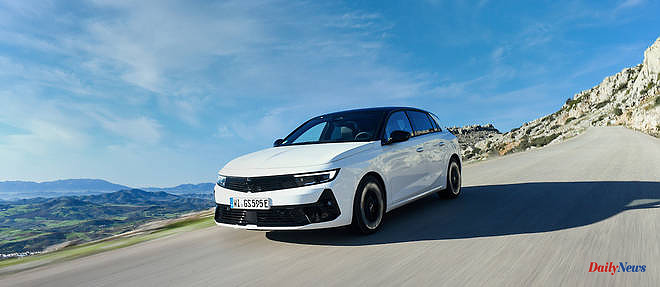Opel has promised, from 2028, the brand will only offer 100% electric vehicles in Europe. But as it is necessary to continue to run the company until then, it is to the rechargeable hybrid that the manufacturer from Rüsselsheim relies on it to ensure the transition. And to make this motorization more desirable and, no doubt, to make people forget its few congenital flaws (weight, price, charging, etc.), it goes so far as to resuscitate the GSe acronym which traditionally applied to the sports models in the range (Comodore from 1970, Monza from 1983, for example). Except that, sign of the times, today GSe no longer means Grand Sport Einspritzung (injection), but Grand Sport Electric. You understood, this new Astra intends to put electricity and sportiness on its menu.
As for the look, it does not add too much. A big black mouth that opens into the front fascia, a black logo on the tailgate and 19-inch wheels inspired by those of the Manta GSe concept, that's about all that sets it apart. The sport chic look is no less successful. Minimum service also inside, with more enveloping sports seats covered in Alcantara. The presentation therefore remains a little austere, but the large digital panel that adorns the dashboard still has an effect.
Also impressive is the equipment, which includes a steering wheel and heated front seats, a 360° camera, front and rear parking assistance, a multimedia navigation system and a battery. driving aids (anti-collision alert, pedestrian and drowsiness detection, sign reading, automatic cruise control, etc.). Enough to justify, at least partially, a frankly salty price: 47,400 euros, it's 780 euros more than the equivalent Peugeot 308 with which it shares most of the mechanics.
Under the bonnet, precisely, it is the proven four-cylinder 1.6-litre turbo from the PSA group that we find, here in its 180 hp version. It is associated for the occasion with a 110 hp electric motor, also placed on the front axle. The cumulative power thus stands at 225 hp, with a maximum torque of 360 Nm. What offer, despite a substantial weight (1,703 kg), honorable performance for this sedan: 235 km / h in top speed and 7, 5 sec. to accelerate from 0 to 100 km/h.
With a capacity of 12.4 kW, the battery allows, according to the WLTP standard, to travel up to 64 km in 100% electric mode. In practice, you should not count on more than 50 km. This already allows zero-emission traffic in the city most of the time. Provided, of course, that the battery is charged. Because this is one of the main weaknesses of plug-in hybrids; they only make sense if you take the trouble to regularly charge their battery. Small in size, it unfortunately empties too quickly and takes time to recharge: 3h25 with the 3.7 kW charger supplied as standard, 1h40 with the 7.4 kW charger offered as an option (400 euros ). During our test on a varied route, fuel consumption in hybrid mode thus came out at 5.8 l/100 km in quiet driving, 7.7 l at a good pace, but more than 10 l once the uncharged battery. This makes long journeys much less virtuous.
As for the sensations in sporty driving, let's be honest, we're a little unsatisfied. Without being staggering, the accelerations and the times are, of course, effective, but the motorization is not very expressive. The revs are linear, the engine noise not very stimulating and the 8-speed automatic transmission shines more for its smoothness than its responsiveness, even when using sport mode and the paddles on the steering wheel.
The road behavior is in tune. The chassis has however benefited from serious changes, with a body lowered by 10 mm, recalibrated steering and significantly firmer suspensions using Koni FSD (Frequency Selective Damping) shock absorbers supposed to provide, without electronic control, effective filtration both at high and low levels. at low frequency. Clearly, it is their responsibility to ensure that the body is well maintained, while maintaining a suitable level of comfort. The thing is, it works pretty well. But that's not enough to make this Astra a fun car to drive. Already handicapped by its weight, it must indeed deal with green tires with low rolling resistance that are not very suitable and, above all, with chassis settings that favor stability too much to the detriment of agility. In the end, it is therefore to the rhythm of a more grand touring than sporty driving that we appreciate this GSe. Even in all-electric mode, where its softness and silence work wonders in town. We say, then, that a 180 hp hybrid Astra GS does the job just as well, for much less (43,150 euros). Finally, note that a Sports Tourer break version of this same Astra GSe will be marketed later for a supplement which should be around 1,150 euros.
MOST
- All-electric city mode
- Rewarding presentation
- Extensive equipment
- Safe handling
THE LESSERS
- Lack of feeling
- Not very fun behavior
- Discharged battery consumption
- High price
Under the hood of the Astra GSe
Heat engine: gasoline 4 cyl. turbo
Displacement: 1598cc
Power: 180 hp
Electric motor: 110 hp, front
Batterie : lithium-ion 12,4 kWh
Electric range: 64 km (WLTP)
Charging time 3.7 kW station (standard): 3 h 25
Cumulative power: 225 hp
Couple maxi : 360 Nm
Transmission: front wheel
Transmission: 8-speed automatic
Dimensions : 4374 x 1860 x 1442
Trunk: 352 / 1268 liters
Weight: 1703kg
Acceleration from 0 to 100 km/h: 7.5 sec.
Speed: 235 km/h (135 km/h electric)
Consumption: 1.2 l/100 km
CO2 : 26 g/km
Price: €48,250












